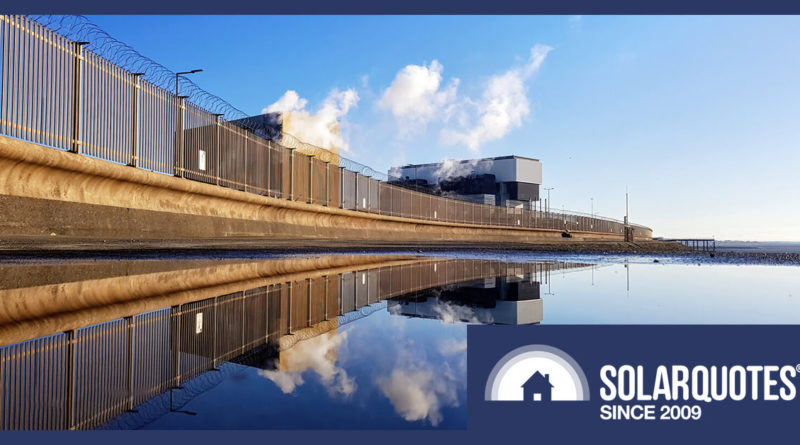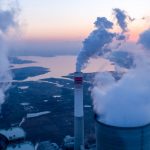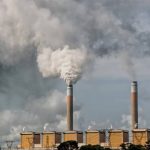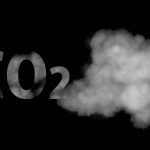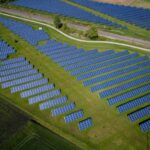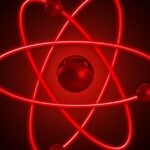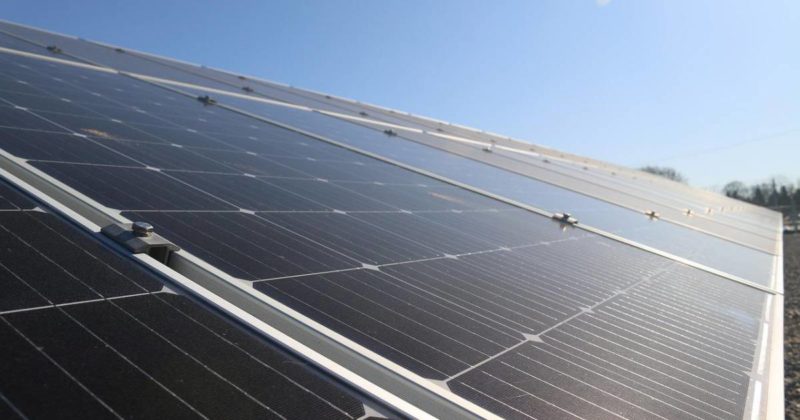Russian Invasion Makes IEA Nuclear Predictions Impossible
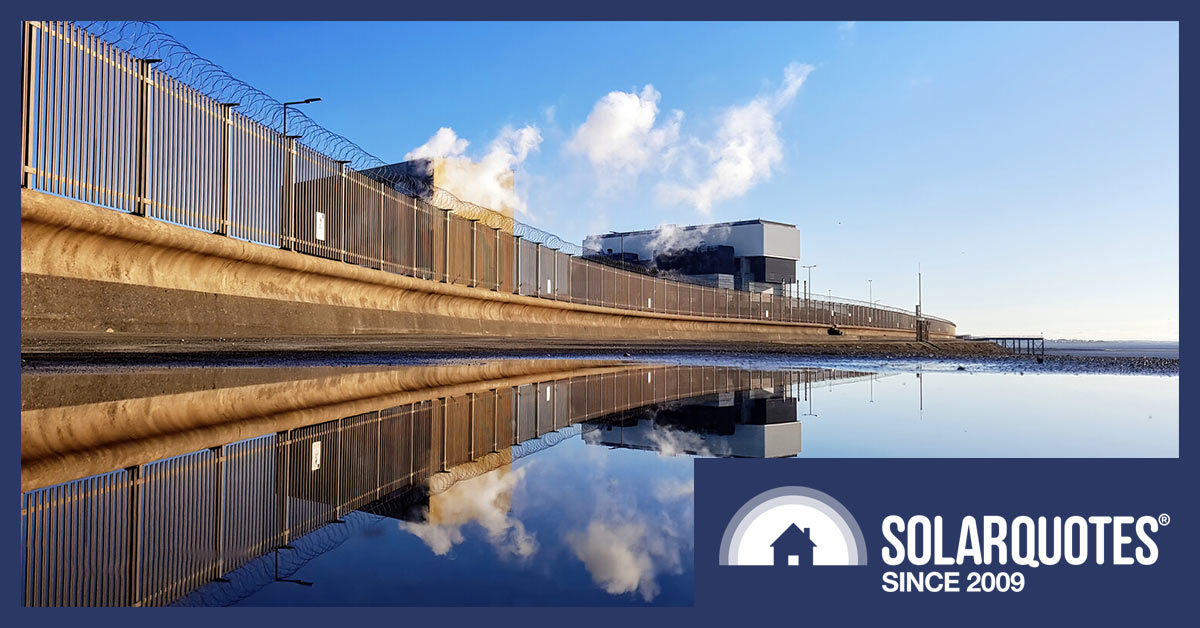

Last year the International Energy Agency (IEA) published a long report where — among other things — they predicted the rate of new nuclear construction would roughly double. When I first read this, I considered it nearly impossible. But now Russia has invaded Ukraine, I consider it flat out impossible. I expect new nuclear power will provide much less low emissions energy in coming decades than the IEA predicts.
A Long IEA Report
At the end of February, I wrote a looong blog post about a looong IEA report called…
In this post I’ll cover what the IEA report says about nuclear power and why their predictions were too optimistic even before the invasion of Ukraine.
The IEA report predicts new wind and solar power capacity will produce at least six times as much energy as new nuclear by 2040. This makes it seem like they don’t expect much growth in nuclear power generation, but even for their least optimistic prediction to come true, two things are required:
- A large decrease in the growth rate of solar and wind generation.
- A doubling of the growth rate for new nuclear power.
I don’t consider either of these prospects to be realistic. Now Putin has invaded Ukraine, I consider their predictions to have gone from unrealistic to unbelievable.
Massive Increase In Solar & Wind Compared To Nuclear
The IEA report considers two different scenarios:
- STEPS: In this is their STatEd Policies Scenario1, which assumes nations only meet commitments made in the Paris Climate Accord.
- SDS: This is the Sustainable Development Scenario where nations go beyond current commitments because of falling costs and/or increasing desire to slow climate change.
This graph shows how much generating capacity the IEA report predicts will be built for nuclear, wind, and solar power from 2020 to 2040 in each scenario:
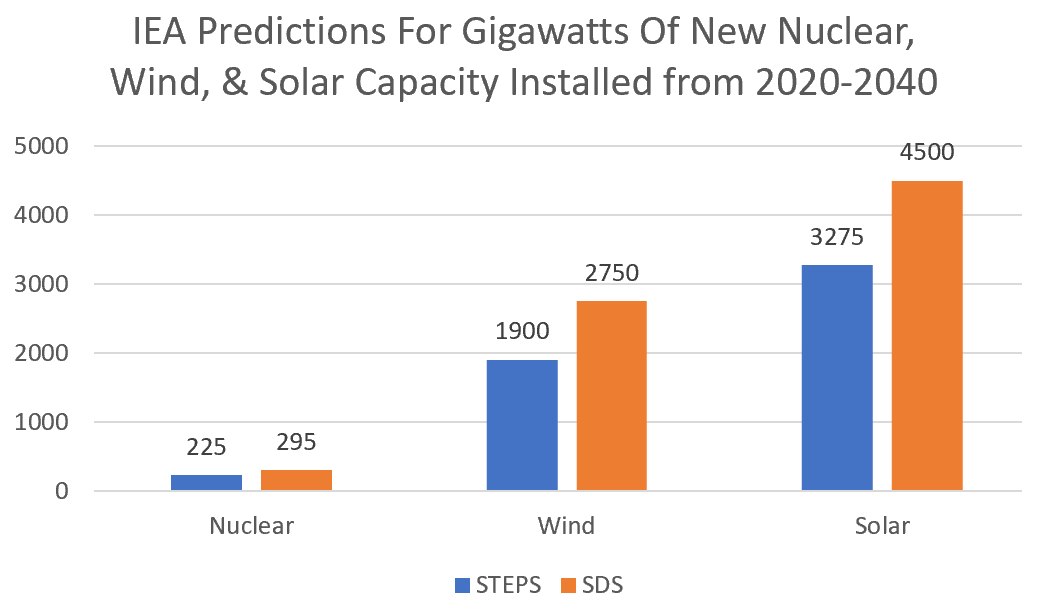

This makes it look like the IEA thinks new nuclear won’t play a significant role in the future compared to renewables. But comparing total capacity can be misleading. One gigawatt of nuclear power capacity provides much more energy than one gigawatt of solar or wind capacity. Capacity factor must be taken into account, otherwise, it’s like comparing high capacity factor apples to low capacity factor apples.
Capacity factor is how much energy is generated in the real world compared to how much would be generated if it continuously operated at its full rated capacity. I can’t be certain what the average capacity factor for new generation will be, but these estimates should be close:
- Nuclear 90%
- Wind 38%
- Solar 18%
Using these capacity factors I can estimate how much energy the IEA believes will be produced in 2040 by new generating capacity built from 2020:
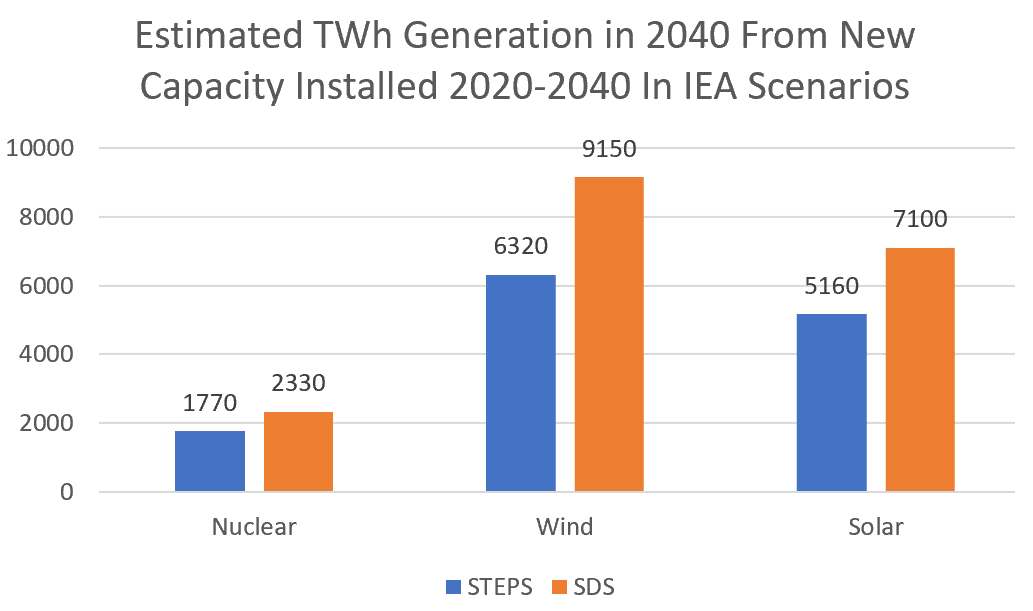
If you are wondering what TWh is – it stands for terawatt hour, which is one billion kilowatt-hours. One TWh is about how much electrical energy Bendigo uses in a year.
This makes new nuclear’s contribution appear a lot better. Compared to the total of wind and solar generation…
- STEPS: New nuclear is 15% of new wind and solar generation.
- SDS: New nuclear is 14% of new wind and solar generation.
With only 1 percentage point difference, the output of new nuclear is almost the same in relation to the output of new wind and solar energy generation in either scenario.
In reality, I expect the percentage of energy produced by new nuclear power will be much less because:
- I expect wind and solar generation to be higher than in either of the IEA’s scenarios.
- The IEA’s estimate for new nuclear construction is unrealistically high even for the less optimistic STEPS prediction.
- Putin’s invasion of Ukraine has caused the IEA’s rosy forecasts for new nuclear energy for this decade to go from unrealistic to impossible.
IEA Predicts A Large Decline In Growth Of Solar & Wind Growth
While the IEA report predicts a huge increase in renewable generating capacity by 2040, even their more optimistic scenario requires a large slowdown in the rate of growth of solar and wind. While a reduction is inevitable2 at some point…
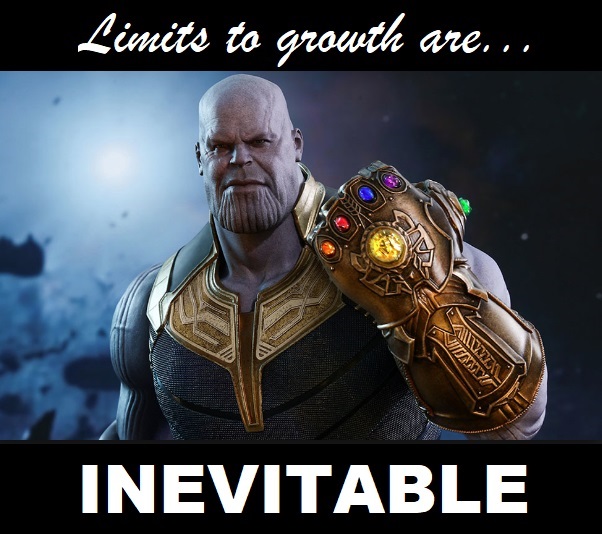

…the IEA has made this same prediction and got it wrong around 14 times in the past. I consider the odds of them being right this time to be slim.
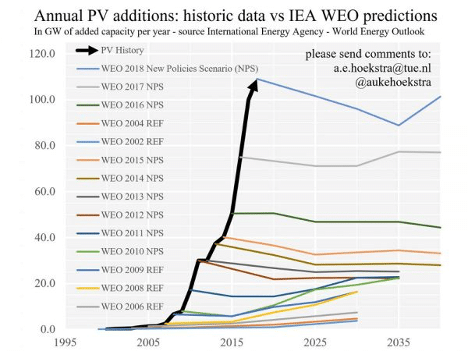
According to this, the IEA has predicted a decline in the growth of renewables about 14 times in the past was wrong each time. (Source: Apparently a Dutch person. So must be legit.)
Because solar and wind generation — along with battery storage — has been falling in cost while other forms of generation have not, I don’t think we’ll see anything like the growth slowdown the IEA predicts. On the graph below I’ve compared wind and solar capacity built in 2021 with the IEA’s prediction for how much will be built in their optimistic SDS forecast in 2030, along with how much will be installed if solar and wind capacity continue to expand a the same rate they have over the previous 10 years:
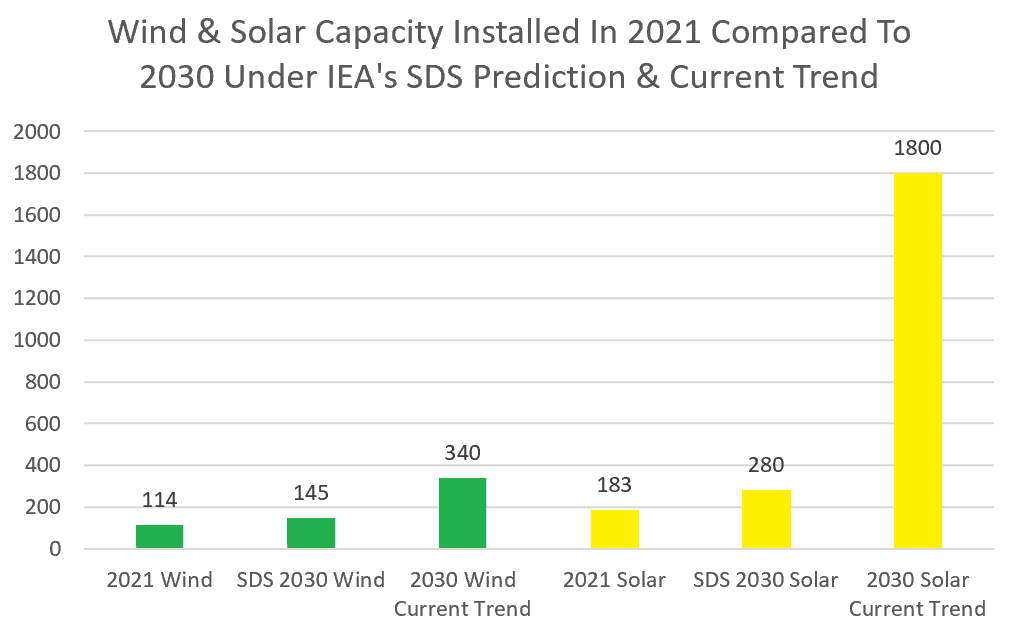

In the SDS prediction for 2030, compared to what was installed in 2021…
- Wind: Only 27% more will be installed in 2030 than 2021.
- Solar: Only 53% more will be installed in 2030 than 2021.
If current trends continue, then compared to the SDS prediction for 2030…
- Wind: 230% more wind capacity will be built.
- Solar: 640% more solar capacity will be built.
I’m not saying current trends will continue, but I am saying there is a lot of room for installations to be far higher than in the IEA’s more optimistic forecast.
Nuclear Power
The report predicts large decreases in solar and wind capacity growth rates, so you may expect a similar prediction for nuclear power. Instead, despite the falling cost of renewable energy, a large increase in nuclear’s growth rate is forecast. Something that’s now impossible — unless Emperor Putin makes reactor construction a condition of our continued existence.
For the past 10 years, the nuclear construction rate has been low. The graph below shows new nuclear power capacity built over this time, along with retirements:
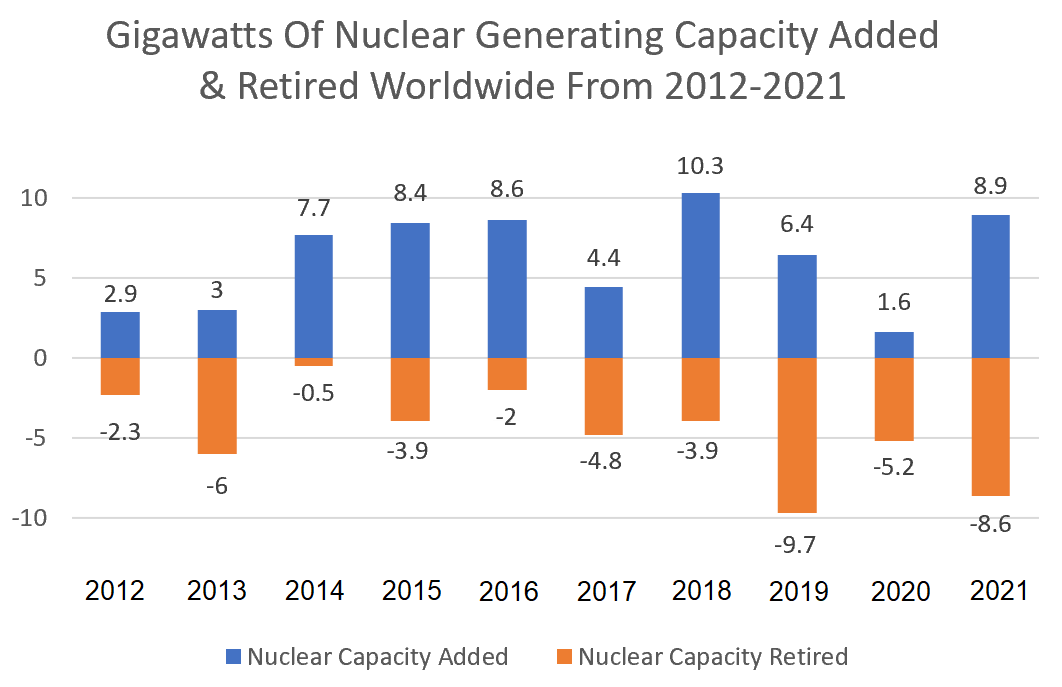
New nuclear construction has had a hard time keeping ahead of old reactors closing down, with retired capacity equal to around two-thirds of new capacity over the past 10 years. On average the net increase in nuclear capacity has been around 1.5 gigawatts per year.
The largest addition to nuclear capacity over the past 10 years was 10.3 gigawatts in 2018, while the lowest was in 2020 with 1.63 gigawatts. But in the IEA report, their graph puts nuclear power capacity added in 2020 at close to 10 gigawatts — six times the actual amount:
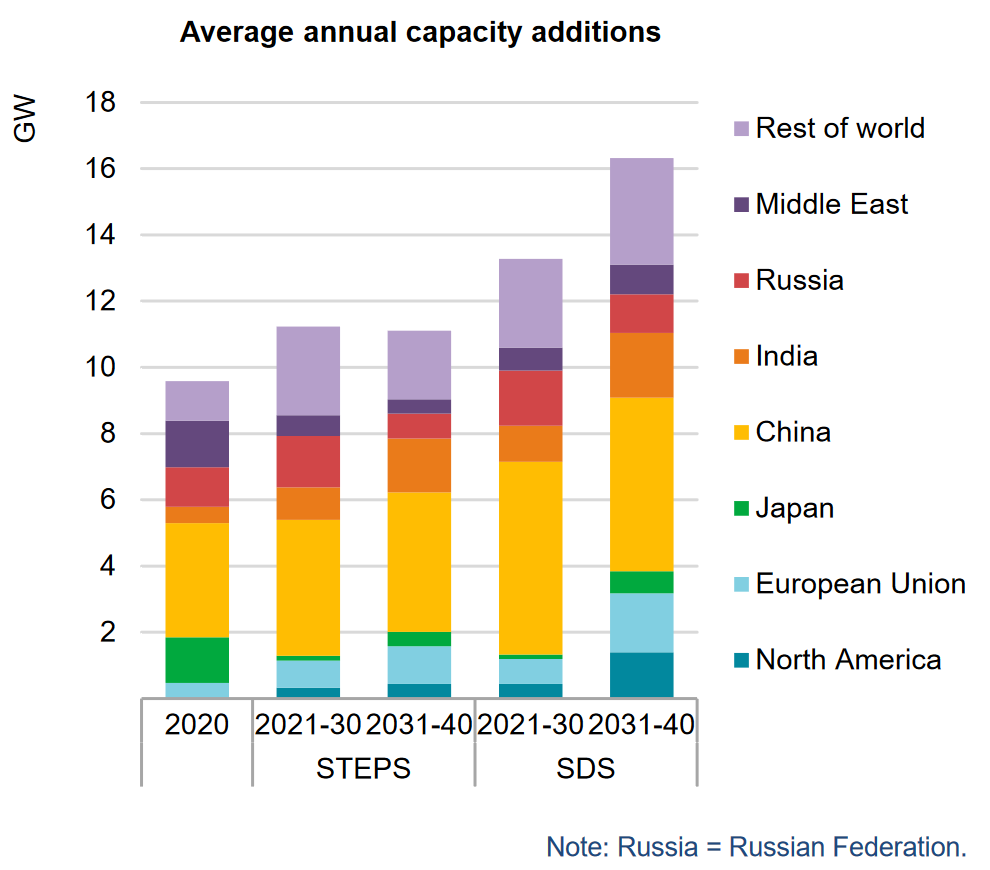

I checked the World Nuclear Association’s figures, and they say the world connected 3.176 gigawatts of new nuclear capacity to the grid in 2020. This is not the same as new reactors being commissioned and entering normal operation, but it’s still under one-third the IEA’s figure. I don’t know how the IAE got it so wrong, but this mistake really stands out as 2020 was the year with the lowest new nuclear power capacity addition for a very long time.
The IEA report says from 2021-2030 the world will see an average of over 11 gigawatts of new nuclear capacity commissioned each year in their STEPS prediction, and more than 13 gigawatts in their more optimistic SDS forecast. Over the past 10 years the world only averaged 6.2 gigawatts of new nuclear capacity commissioned each year, so even meeting the lower estimate of around 11 gigawatts is not realistic because, in the less than nine years that are left, the world would have to almost double the average rate of construction.
This would be easy for solar, wind, or battery capacity to achieve but — unlike these technologies — nuclear power is not a high growth industry. Even if there was a sudden increase in demand for nuclear energy generation it would take years for construction to ramp up.
Currently, there are only around 55 nuclear reactors, totalling approximately 45 gigawatts3, under construction. Over the past 40 years, the average construction time has been around 7 years. Assuming none of these projects are cancelled, which is unlikely, this suggests only around 6.5 gigawatts of new capacity will enter service each year.
Even if large new projects are announced, this is unlikely to change. For example, Macron recently announced France would build new reactors but, even if all goes well, the first isn’t likely to come online before 2035. Note things often don’t go well for nuclear power in France. Their Flamanville 3 reactor, which was supposed to be completed in 2012, has just had its commissioning delayed for at least two years.
Nuclear Power Is Not Competitive
An increase in nuclear construction is unlikely due to the high cost of nuclear power. I don’t expect small modular reactors to change this because, if cost overruns are ignored, the energy they provide is projected to be more expensive than larger reactors. While they may reduce cost overruns, current designs don’t have the potential to compete with renewable energy. If they did, India — which has 17 operational reactors of 205 megawatts or less — probably wouldn’t have stopped building them to concentrate on larger designs of 630 megawatts and up.
Nuclear power is unlikely to ever compete with renewable energy no matter what reactor technology is used. This is because, like coal power, it requires expensive heat exchangers4 while solar and wind generation have no need for them.
Nuclear’s Material Needs Are Low
One thing the IEA report mentions is nuclear power’s need for materials such as copper and nickel are less per kilowatt-hour generated than most forms of generation. This is mainly because modern nuclear reactors are designed to operate at a 90% or higher capacity factor. In comparison, new Australian wind power has a capacity factor of around 40%, while fixed solar is around 24% in Longreach and 14% on a north-facing roof in Hobart.
Nuclear’s high utilization rate makes its need for copper similar to run-of-the-river hydroelectricity5 per kilowatt-hour generated. On the downside, we can’t recycle some material used by nuclear power stations for a very long time. This is because it becomes radioactively contaminated and must be disposed of thoughtfully6.
Despite requiring much less material per kilowatt-hour generated than wind or solar generation, nuclear power is still far more expensive. Its lower material requirements are not enough to make it worthwhile economically or environmentally. This is because fossil fuel generation can be shut down faster and at less cost than by building renewable generation rather than nuclear.
Nuclear’s Future Harmed By Russian Invasion
Russia’s invasion of Ukraine has reduced the amount of new nuclear capacity we can expect to be built for two main reasons:
- Sanctions will cause reactor construction in Russia to halt and potentially be cancelled altogether.
- International nuclear power plant projects involving Russia are likely to be delayed or cancelled.
There is also a third reason which is less important, but may become number one if things go badly wrong:
- Fighting around the Chernobyl and Zaporizhzhia nuclear plants have made people think more about nuclear power’s liabilities.7
Russian Reactor Construction Will Halt
Currently, there are only two conventional nuclear reactors under construction in Russia, along with a 280 megawatt molten lead cooled prototype. Because Russian industry is heavily dependent on foreign machine tools and expertise, sanctions will cause work on these projects to come to a halt, whether they want it to or not.
Because they provide Putin with no immediate benefit, Russia’s limited foreign exchange reserves won’t be used to keep reactor construction going. While construction could start up in the future, it’s possible this will never happen. So far, Russia has started work on and then abandoned 19 nuclear power reactors8. If more end up added to the total I won’t be terribly surprised.
International Projects May Halt
While the halt and potential abandonment of work on Russian reactors are bad for nuclear energy’s prospects, the effects on international projects involving Russia may be greater.
Rosatom, Russia’s State Atomic Energy Corporation, is involved with nuclear power plants either under construction or planned in:
- Bangladesh
- Belarus
- China
- Egypt
- Finland
- Hungary
- India
- Turkey
While Rosatom isn’t directly targeted by sanctions at this time, projects may still be cancelled or delayed. For example, Finland has cancelled work on the Hanhikivi Nuclear Power Station that was to be built by Rosatom.
Another potential problem is Russia is a major supplier of nuclear fuel and current sanctions will make it difficult to maintain production. Reduced supply could raise its price, making nuclear energy even less economical than it already is.
If the international situation suddenly takes a turn for the far better, sanctions on Russia may be rapidly removed. But, even in this rosy scenario, the Russian economy will still be heavily damaged by the events of the past month for a long time to come and nuclear energy projects are still likely to be delayed or cancelled.
What’s Up With The IEA?
Between consistently under-predicting the expansion of renewable energy and forecasting an expansion of nuclear energy that was implausible even before the invasion of Ukraine, I’m kind of getting the impression the IEA considers its job to be letting politicians and business people know the world is changing while reassuring them it’s not changing too much.
This may not be done consciously, but you’d think they would have started to learn from their mistakes by now. Overestimating the amount of new nuclear capacity coming online in 2020 by a factor of six was a particularly puzzling error because IEA reports are normally free of typos and mathematical errors. It’s only their conclusions that tend to be stuck in the mud.
But that’s all I have to say. You now know everything about the IEA’s predictions for nuclear power from A to Z. This is the end of the article because, as everyone knows, Z always comes last.
Unfortunately, it has taken me 2,543 words to get here, which is well over the limit I set myself. I was going to tell you my favourite Ukrainian joke but, because it’s way too long, I’ll just mention a short Russian joke:
Putin.
Footnotes
- You can tell some really wanted the acronym to come out as STEPS. Someone in the IEA must have a huge weakness for Euro cover bands. ↩
- Limits to physical growth are unavoidable because the universe is expanding and entropy increasing. But there are no actual limits to economic growth as this is based on human desire. Depending on how literally you take certain economic theories, we can have unlimited economic growth by selectively breeding people to be greedier. ↩
- The World Nuclear Association says there are 58 gigawatts of nuclear capacity under construction, but their definition of under construction includes “thinking really hard about it”. The International Atomic Energy Agency says 53.6 gigawatts. I say, “If you ain’t pouring concrete, you ain’t serious”. ↩
- Yes, there are nuclear reactors that don’t require heat exchangers, but they won’t ever be cheaper than ones that have them. ↩
- This type of hydroelectricity doesn’t need a dam thing to store water. ↩
- This problem isn’t unique to nuclear power. Some pipes in natural gas refineries can become radioactive because of naturally occurring radon gas. But the problem is way worse for nuclear. ↩
- Speaking of liabilities, did you know the Chernobyl nuclear disaster caused radioactive silt to be deposited in the Kyiv Reservoir? If the dam wall is destroyed, in addition to the normal devastation that would result, it could result in a major radiological hazard. Fortunately, the dam is very strong and so very unlikely to be destroyed — by accident. ↩
- Going belly up before construction is complete is one of the major financial risks of nuclear power but, for some reason, it’s rarely mentioned. ↩
Original Source: https://www.solarquotes.com.au/blog/russian-invasion-iea-nuclear/

